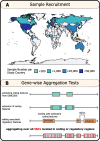Aggregation tests identify new gene associations with breast cancer in populations with diverse ancestry
- PMID: 36703164
- PMCID: PMC9878779
- DOI: 10.1186/s13073-022-01152-5
Aggregation tests identify new gene associations with breast cancer in populations with diverse ancestry
Abstract
Background: Low-frequency variants play an important role in breast cancer (BC) susceptibility. Gene-based methods can increase power by combining multiple variants in the same gene and help identify target genes.
Methods: We evaluated the potential of gene-based aggregation in the Breast Cancer Association Consortium cohorts including 83,471 cases and 59,199 controls. Low-frequency variants were aggregated for individual genes' coding and regulatory regions. Association results in European ancestry samples were compared to single-marker association results in the same cohort. Gene-based associations were also combined in meta-analysis across individuals with European, Asian, African, and Latin American and Hispanic ancestry.
Results: In European ancestry samples, 14 genes were significantly associated (q < 0.05) with BC. Of those, two genes, FMNL3 (P = 6.11 × 10-6) and AC058822.1 (P = 1.47 × 10-4), represent new associations. High FMNL3 expression has previously been linked to poor prognosis in several other cancers. Meta-analysis of samples with diverse ancestry discovered further associations including established candidate genes ESR1 and CBLB. Furthermore, literature review and database query found further support for a biologically plausible link with cancer for genes CBLB, FMNL3, FGFR2, LSP1, MAP3K1, and SRGAP2C.
Conclusions: Using extended gene-based aggregation tests including coding and regulatory variation, we report identification of plausible target genes for previously identified single-marker associations with BC as well as the discovery of novel genes implicated in BC development. Including multi ancestral cohorts in this study enabled the identification of otherwise missed disease associations as ESR1 (P = 1.31 × 10-5), demonstrating the importance of diversifying study cohorts.
Keywords: Breast cancer susceptibility; Diverse ancestry; Gene regulation; Genome-wide association study; Rare variants.
© 2023. The Author(s).
Conflict of interest statement
S.H.M. became an employee of Boehringer Ingelheim after completing this study. Matthias W. Beckmann conducts research funded by Amgen, Novartis, and Pfizer. P.A.F. conducts research funded by Amgen, Novartis, and Pfizer. He received Honoraria from Roche, Novartis, and Pfizer. R.A.M. is a consultant for Pharmavite. A.W.K. received research funding from Myriad Genetics for an unrelated project (funding dates 2017–2019).
Figures


References
Publication types
MeSH terms
Substances
Grants and funding
- C1287/A10710/CRUK_/Cancer Research UK/United Kingdom
- HHSN261201800015I/CA/NCI NIH HHS/United States
- 29186/CRUK_/Cancer Research UK/United Kingdom
- C12292/A11174/CRUK_/Cancer Research UK/United Kingdom
- G1000143/MRC_/Medical Research Council/United Kingdom
- P30 CA008748/CA/NCI NIH HHS/United States
- Z01 ES044005/ImNIH/Intramural NIH HHS/United States
- Z01 ES049033/ImNIH/Intramural NIH HHS/United States
- UM1 CA164917/CA/NCI NIH HHS/United States
- R03 CA130065/CA/NCI NIH HHS/United States
- C1275/A19187/CRUK_/Cancer Research UK/United Kingdom
- P30 ES010126/ES/NIEHS NIH HHS/United States
- C8221/A19170/CRUK_/Cancer Research UK/United Kingdom
- R01 CA148667/CA/NCI NIH HHS/United States
- HHSN261201800032I/CA/NCI NIH HHS/United States
- U19 CA148112/CA/NCI NIH HHS/United States
- R01 CA120120/CA/NCI NIH HHS/United States
- 14136/CRUK_/Cancer Research UK/United Kingdom
- HHSN261201800009I/CA/NCI NIH HHS/United States
- U01 CA176726/CA/NCI NIH HHS/United States
- C1275/C22524/CRUK_/Cancer Research UK/United Kingdom
- Z01 CP010119/ImNIH/Intramural NIH HHS/United States
- C1287/A16563/CRUK_/Cancer Research UK/United Kingdom
- MC_UU_00004/01/MRC_/Medical Research Council/United Kingdom
- P30 CA033572/CA/NCI NIH HHS/United States
- C5047/A10692/CRUK_/Cancer Research UK/United Kingdom
- P30 CA023100/CA/NCI NIH HHS/United States
- C490/A16561/CRUK_/Cancer Research UK/United Kingdom
- P50 CA058223/CA/NCI NIH HHS/United States
- 1000143/MRC_/Medical Research Council/United Kingdom
- C490/A10124/CRUK_/Cancer Research UK/United Kingdom
- R01 CA192393/CA/NCI NIH HHS/United States
- C5047/A8384/CRUK_/Cancer Research UK/United Kingdom
- NU58DP006344/DP/NCCDPHP CDC HHS/United States
- C570/A16491/CRUK_/Cancer Research UK/United Kingdom
- U19 CA148065/CA/NCI NIH HHS/United States
- C1275/A11699/CRUK_/Cancer Research UK/United Kingdom
- UM1 CA186107/CA/NCI NIH HHS/United States
- MR/M012190/1/MRC_/Medical Research Council/United Kingdom
- C5047/A15007/CRUK_/Cancer Research UK/United Kingdom
- PGFAR 0707-10031/DH_/Department of Health/United Kingdom
- Z01 ES049030/ImNIH/Intramural NIH HHS/United States
- P50 CA125183/CA/NCI NIH HHS/United States
- R01 CA176785/CA/NCI NIH HHS/United States
- IS-BRC-1215-20007/DH_/Department of Health/United Kingdom
- D43 TW009112/TW/FIC NIH HHS/United States
- 16563/CRUK_/Cancer Research UK/United Kingdom
- K24 CA169004/CA/NCI NIH HHS/United States
- U54 CA156733/CA/NCI NIH HHS/United States
- R35 CA253187/CA/NCI NIH HHS/United States
- R01 CA077398/CA/NCI NIH HHS/United States
- R01 CA100374/CA/NCI NIH HHS/United States
- C1275/A15956/CRUK_/Cancer Research UK/United Kingdom
- U01 CA164920/CA/NCI NIH HHS/United States
- UM1 CA176726/CA/NCI NIH HHS/United States
- C1281/A12014/CRUK_/Cancer Research UK/United Kingdom
- U01 CA199277/CA/NCI NIH HHS/United States
- UM1 CA164920/CA/NCI NIH HHS/United States
- U01 CA179715/CA/NCI NIH HHS/United States
- C8197/A16565/CRUK_/Cancer Research UK/United Kingdom
- R01 CA116167/CA/NCI NIH HHS/United States
- 10118/CRUK_/Cancer Research UK/United Kingdom
- U19 CA148537/CA/NCI NIH HHS/United States
- 203477/Z/16/Z/WT_/Wellcome Trust/United Kingdom
- C1287/A10118/CRUK_/Cancer Research UK/United Kingdom
- 001/WHO_/World Health Organization/International
LinkOut - more resources
Full Text Sources
Medical
Miscellaneous

